In 1996, the Southampton manager at the time, Graeme Souness, fell victim to a hoax phone call from an individual claiming to be then-FIFA World Player of the Year, George Weah. “Weah” persuaded Souness to give his cousin, forward Ali Dia, an opportunity in the Premier League. Souness obliged. However, it was soon apparent that he had been duped.
Dia made his sole appearance for the Saints, coming on for the injured Matt Le Tissier in the 32nd minute, only to be replaced himself in the 85th minute. This solitary appearance was enough to determine that Dia was not up to the standard of the top flight. It later became apparent that Dia had failed trials at lower-league sides, including Gillingham and Bournemouth.
Such a player recruitment error seems unthinkable in modern football, especially given how clubs have the capability to access a wealth of data on footballers across the globe. It begs the question of how the analysis of such data can be used for scouting.
In this analysis, we will conduct a Principal Component Analysis (PCA) on a large dataset of forward players from the top five divisions in European football. The results of the PCA will determine the types of forward players in the modern game and identify players who shared similar statistics from the 2022/23 season.
Applying PCA
The amount of data gathered on individual players is vast. Therefore, given a dataset of players in the top tiers in England, Germany, Italy, France, and Spain, and numerous variables concerning per 90 statistics, the task of understanding and deriving conclusions can be difficult. This is where PCA comes in useful.
PCA facilitates the analysis of large datasets and enables the visualisation of such multidimensional data. PCA is particularly useful for datasets with several variables correlated with one another. This notion is certainly the case with football. For instance, a player who completes more carries per 90 will likely complete more crosses and/or key passes per 90 as they drive the attacking phase forward.
We have applied PCA to determine the different characteristics associated with different types of forward players in the top five European leagues. These include the Premier League, German Bundesliga, Serie A, Ligue 1 and La Liga. Furthermore, the data is obtained from the 2022/23 season and includes only players who featured for more than the equivalent of 10 90 minutes.
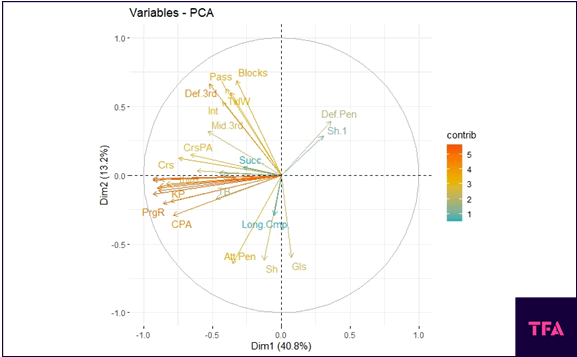
The graphic plots the variables considered in the analysis. Variables further from the origin are more well-represented in the data. Moreover, variables more positively correlated are arranged closer to each other, and those negatively correlated variables have arrows pointing in opposite directions of the origin.
From the graphic above, it is shown that it is common amongst modern forward players to provide crosses, particularly crosses into the penalty area, as well as key passes. This is unsurprising, given the general remit for a forward is to provide an attacking outlet for their respective team.
The above graphic also shows that forward players who are more defensively minded are negatively correlated with forwards who score more goals. This intrinsically makes logical sense as a forward with a more defensive mindset may be a product of their respective teams’ style of play. A defensive team will likely struggle to score goals, which would conform with a defensive forward.
The PCA results indicate the characteristics of different types of forward players. By mapping each player to the PCA results, it is possible to determine which players align with the different characteristics of modern forwards.
Characteristics of forward players
Imagine the scenario: a new manager is appointed in the pre-season and is intent on a particular style of play, but their current squad does not have the capabilities to operate in the manager’s desired system. PCA can help to group characteristics based on players’ stats. The different characteristics will conform to other players, such as a false number nine or a target man.
The PCA that we have undertaken has helped to determine which players conform to different forward roles. Here, we provide a snapshot of some of the types of forwards.
The PCA has shown that forwards who win more tackles per 90 are positively correlated with completing more interceptions, blocks, and defending in the defensive third per 90. Such characteristics suggest a defensive forward. Whilst the concept of a defensive-minded forward may seem illogical, they have been born from deep-lying teams.
Upon reviewing forward players who were more defensive, former Valladolid player Gonzalo Plata ranked highly.
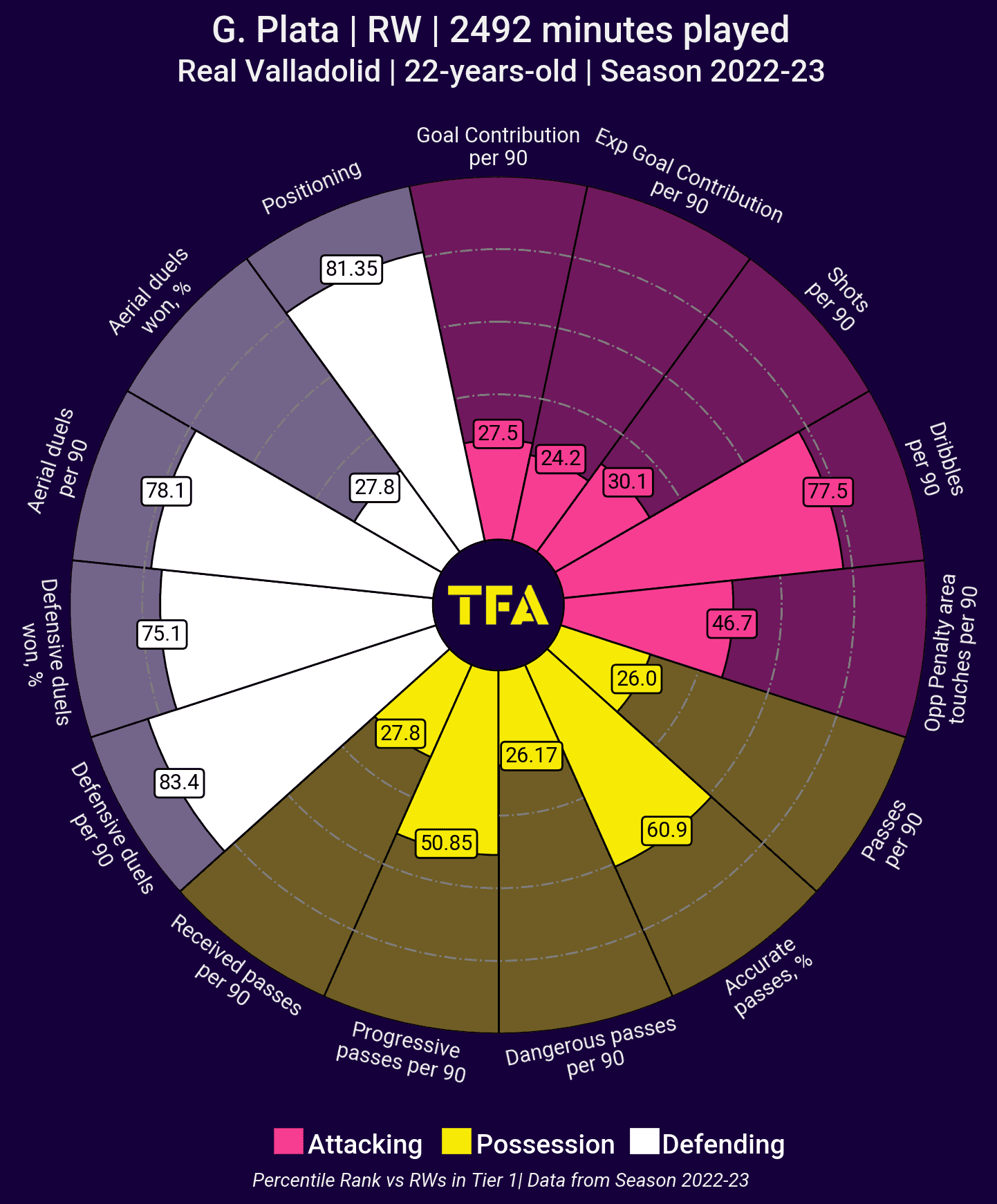
The results of the PCA coincide with the above pizza plot, which shows that Plata ranked highly for the percentage of defensive duels won per 90 compared to other tier-one players. Furthermore, it shows that Plata was less effective in terms of goal contribution compared to others in the same position. He only scored 0.04 goals per 90 last season.
In more recent times, the concept of a false number nine has surfaced. The player occupying this role possesses intelligent off-the-ball movement, looking to draw the opposition’s central defenders to follow. Therefore, it is anticipated that the false nine will have more touches in the middle third of the pitch. The false nine is likely to have a range of passing capabilities, including picking out through balls.
One player who ranked amongst such characteristics was Arsenal’s Gabriel Jesus.

It is shown in the image above that Jesus is recycling possession in the middle third of the pitch, and the opposing defender has followed, leaving space in the opposition’s back line.
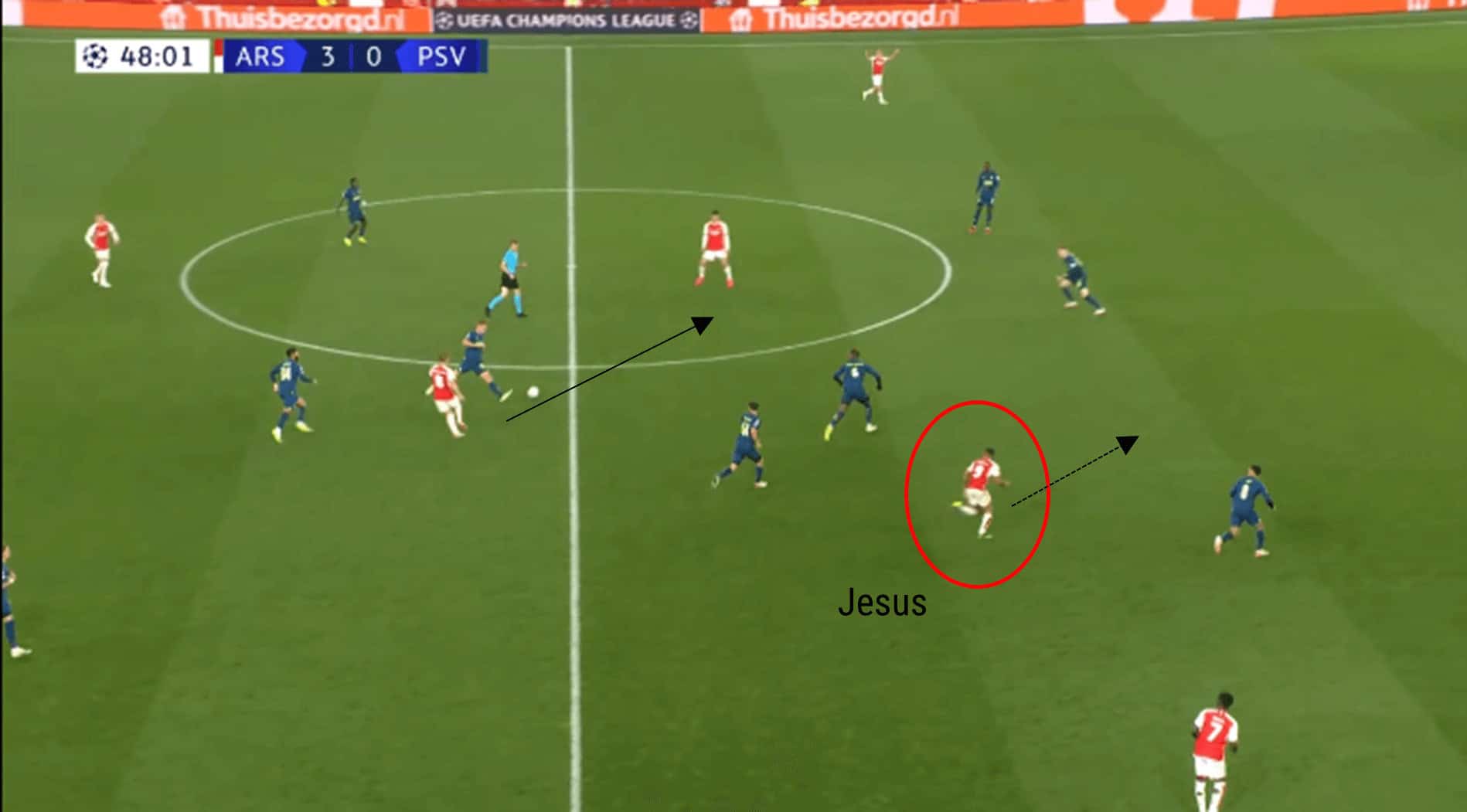
As the Gunners progress their forward play, Jesus is running into the space left by the opposition centre-back. Moreover, the opposing left-back is moving over to cover for his teammate, but this leaves Bukayo Saka with more space on the right-hand side. The movement of Jesus has allowed Arsenal to create space out wide.
A more classic striker is the poacher. The poacher is known for their goals and touches in the attacking penalty area, as they are likely to be more involved in the play in and around the six-yard box. Unsurprisingly, one player who ranked high among the goals was Manchester City forward Erling Haaland.
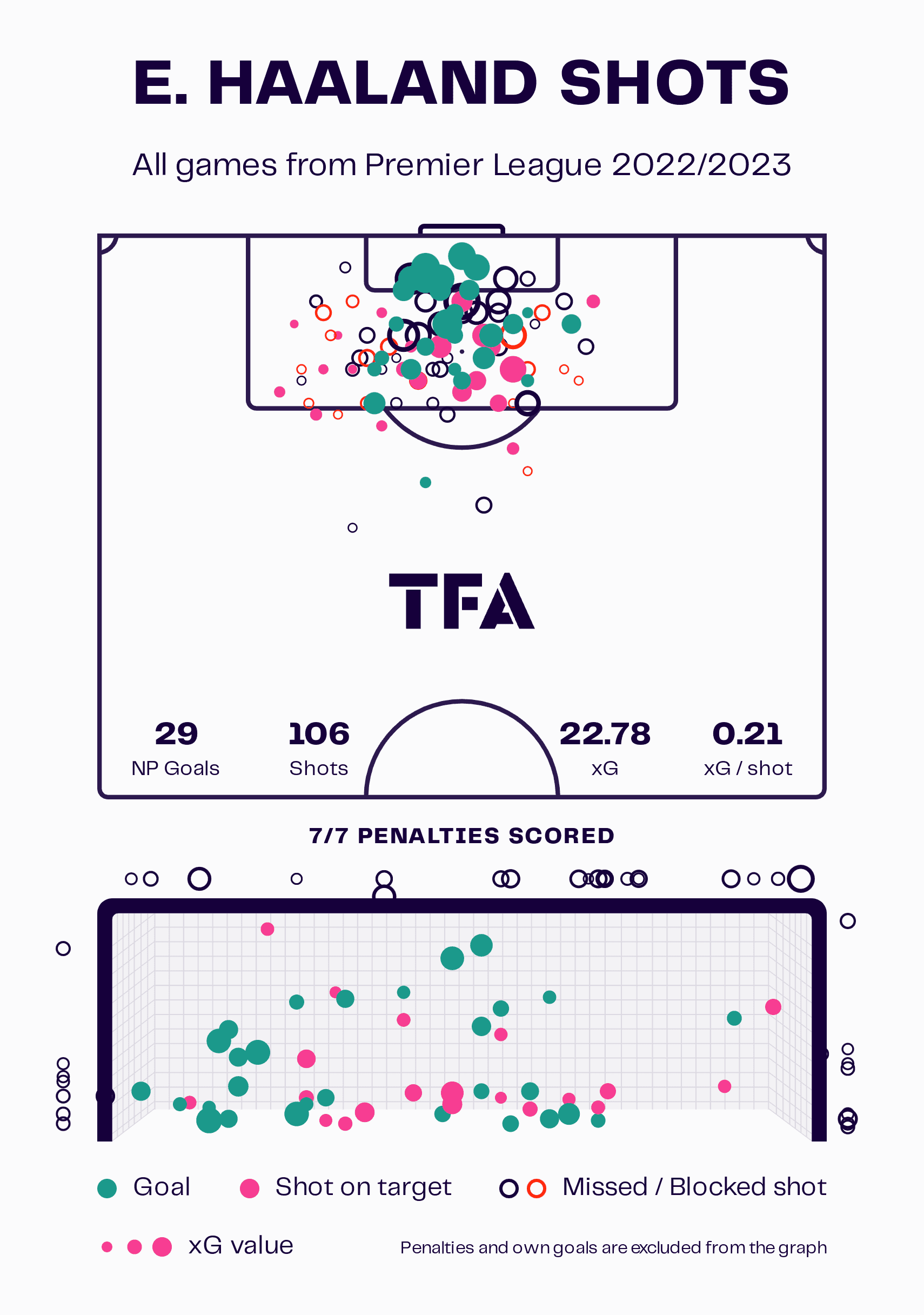
The graphic shows how lethal Haaland was in front of goal last season. The Norwegian had a record-breaking debut season at the Etihad. He became the first player in the history of the Premier League to net a hat-trick in three consecutive home games; he was the quickest player in the Premier League’s history to score two hat-tricks.
With hat-tricks galore, it is unsurprising that Haaland finished the season with 52 goals in all competitions and was the league’s top scorer with 36 goals. He managed to score more goals than he made appearances in the league, scoring 1.17 goals per match. Haaland also converted 25% of his efforts on goal, making him one of the most clinical forwards in the premier league last season. It is noticeable from the above graphic that nearly all his goals in the league came from inside the penalty area, a testament to his poaching ability.
Haaland’s strength and calmness on the ball make him so effective as a poacher. In his play, he is not always selfish, looking to pass into oncoming teammates who have made runs from the midfield. The Norwegian has continued his form this season, ranking as the leading scorer in England’s top tier. He made headlines this season in the league game against Fulham for his three goals and one assist, despite having only 17 touches all match.
Undoubtedly, a poacher will be effective in any team and could be the difference between relegation and escaping the drop. A poacher is likely to be even more of a force with a high standard of players around them. Haaland’s life is undoubtedly made more straightforward by Kevin De Bruyne’s ability to provide a range of high-quality passes.
In recent seasons, a forward three has become common. For example, Liverpool’s former front three of Mo Salah, Sadio Mane, and Firmino were the envy of Europe as they clinched the Champions League in 2019, followed by the Premier League in 2020. This particular front three once led Pep Guardiola to declare how much he feared them.
Therefore, the prominence of wide players suggests forward players are to be strong carriers of the ball and provide passes into the penalty area. The PCA results show that various players across the divisions conformed with such a playing style last season.

The table demonstrates how PCA has been able to identify players with similar per 90 statistics from last season. This leads to another scouting scenario: a player leaves a club, and said club needs to find a replacement.
Hypothetical: what if Martinelli left Arsenal?
A look at the PCA results allows a review of players with similar statistics. One interesting result was Napoli winger Khvicha Kvaratskhelia, who scored similarly to Arsenal’s Gabriel Martinelli.
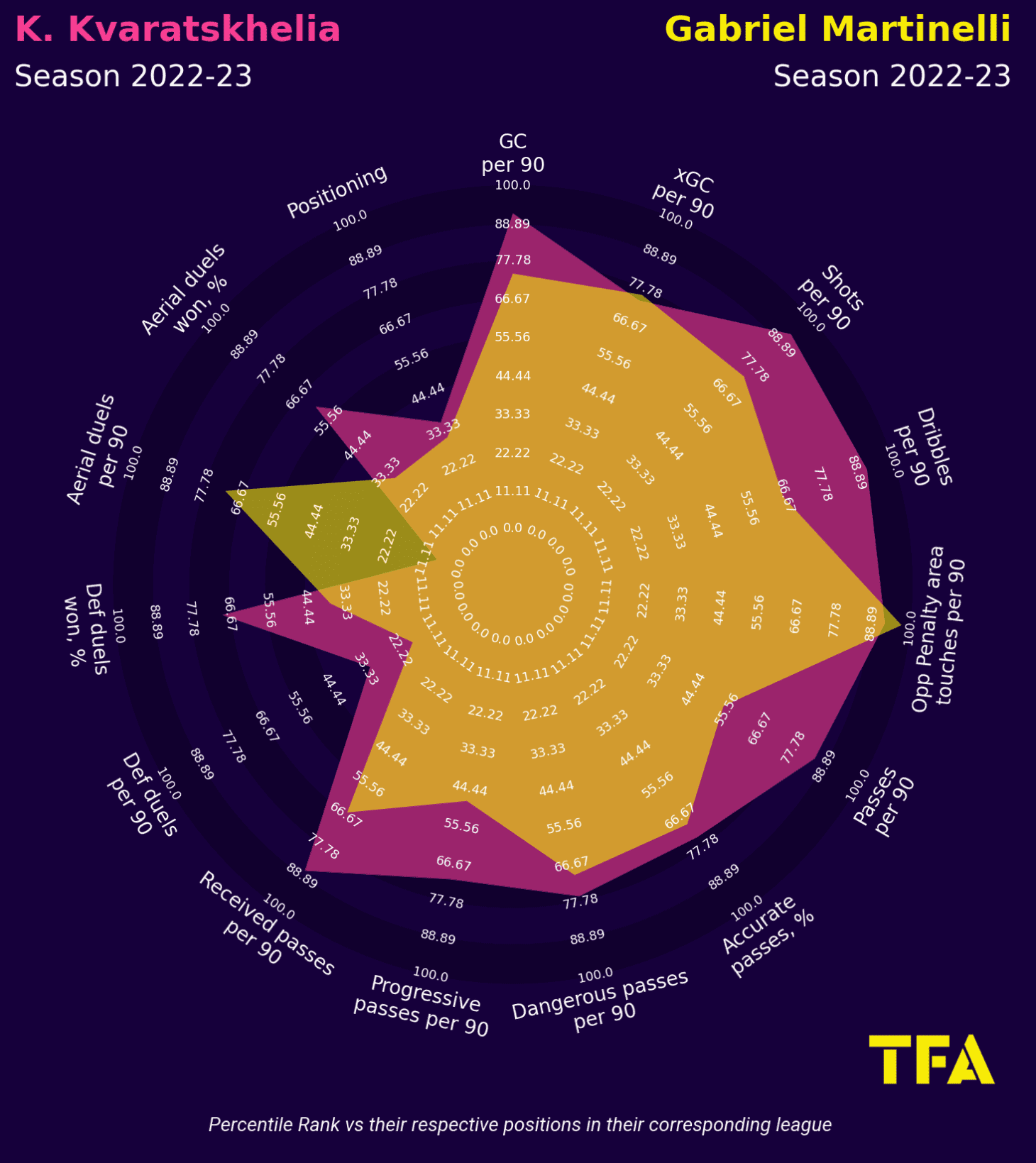
The results suggested similarities between the two, and considering the radar chart above, they were both in similar ranks in their respective divisions last season. Kvaratskheila ranked slightly higher for the majority. The radar chart shows how strong their respective attacking and possession play is.
Only 22 years of age, Kvaratskheila helped Napoli to their first Serie A title since 1990. Playing on the left side, Kvaratskheila’s primary attribute is his speed, which he uses to good effect when carrying the ball. He is also not afraid to invert inside, making him a difficult player to play against; defensively, he often works hard to track back to regain possession for his team.
The Georgian has had a bright start to this campaign, recording 0.56 assists per 90. Furthermore, he currently ranks top of Serie A for total chance-creating carries. This further highlights his ability to dribble with the ball and shows the positive impact it is having on his team.
However, on occasions, Kvaratskheila can be too quick for his own good and is dispossessed as punishment. That being said, he is still only a young player, and considering the impact he has been able to make in Italy’s top tier, there are suggestions he has the attributes to become a top-quality player. Moreover, he possesses the skill to potentially fit into Arsenal’s style of play.
Like Kvaratskheila, Martinelli is quick and particularly lethal in one-on-one situations. The Brazilian finished in the league’s top 10 for attempted take-ons and the top five for successful take-ons last season. Martinelli is known for his runs into the penalty area, which is no coincidence, given Mikel Arteta’s preferred style of play.
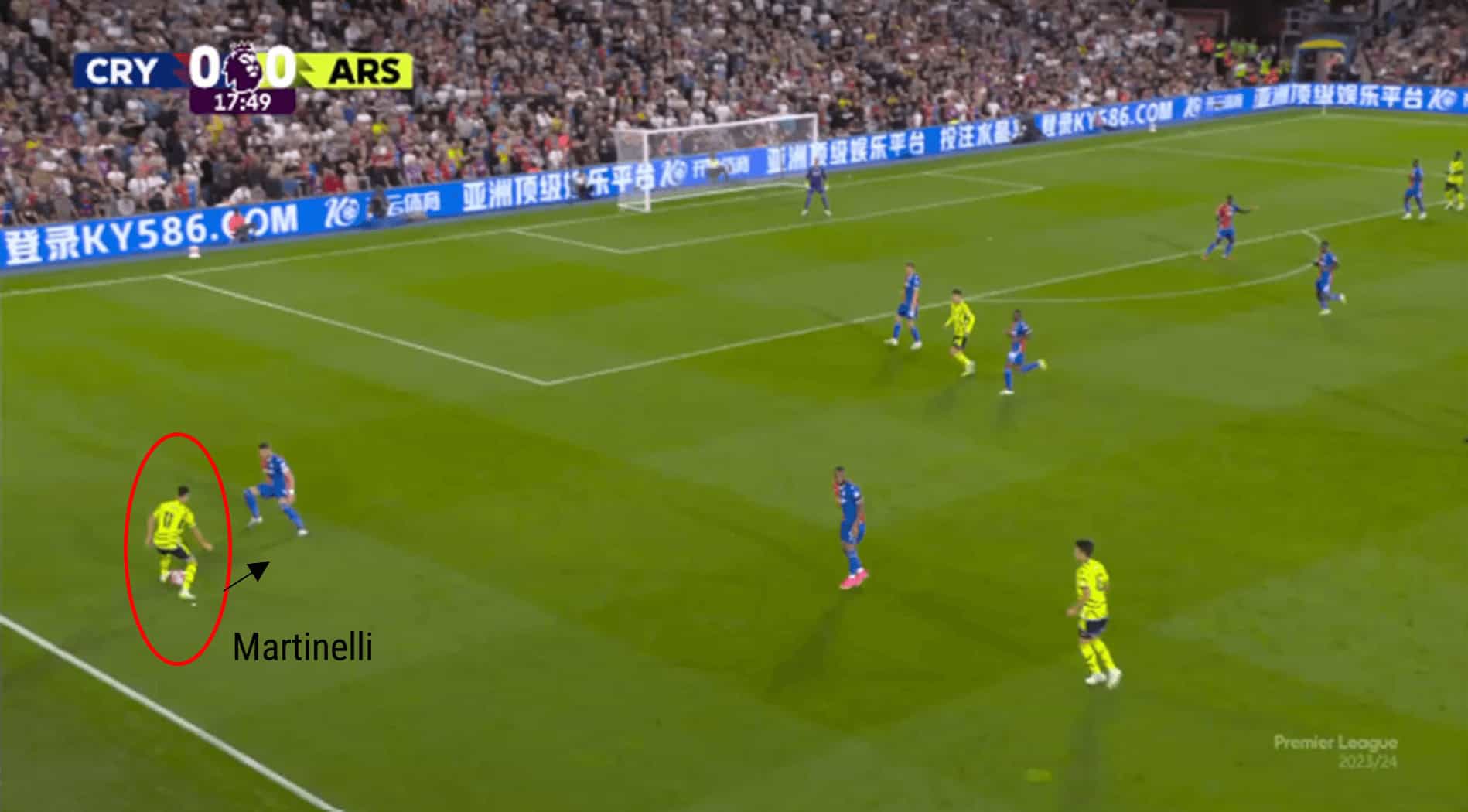
Arteta likes his forwards to receive the ball out wide on an angle towards goal. This enables his attacking options to drive forward toward the goal and have an instant positive influence in progressing the play.
It is shown in the above match still that when Martinelli has received the ball, he is forward facing at an angle toward the goal. The positioning allows him to use his quick feet to good effect, inverting inside to get past the defender.
This style of play would suit the speed and footwork of Kvaratskheila. The Georgian may be one to watch for the future as he could be a player considered a replacement or even competition for Martinelli.
Conclusion
In this analysis, we have shown how statistics, specifically PCA, can be used to scout forward players. From compiling last season’s statistics on numerous players across Europe’s top five divisions, we have seen how specific attributes in football are correlated.
We have been able to use such information to conclude examples of different types of forward players in the modern game.
Moreover, we have seen how effective PCA can be to compare players. Therefore, it is shown that PCA can be a useful initial method in scouting assignments. It provides a good starting block to differentiate between the Dia’s and Haaland’s of the football world.

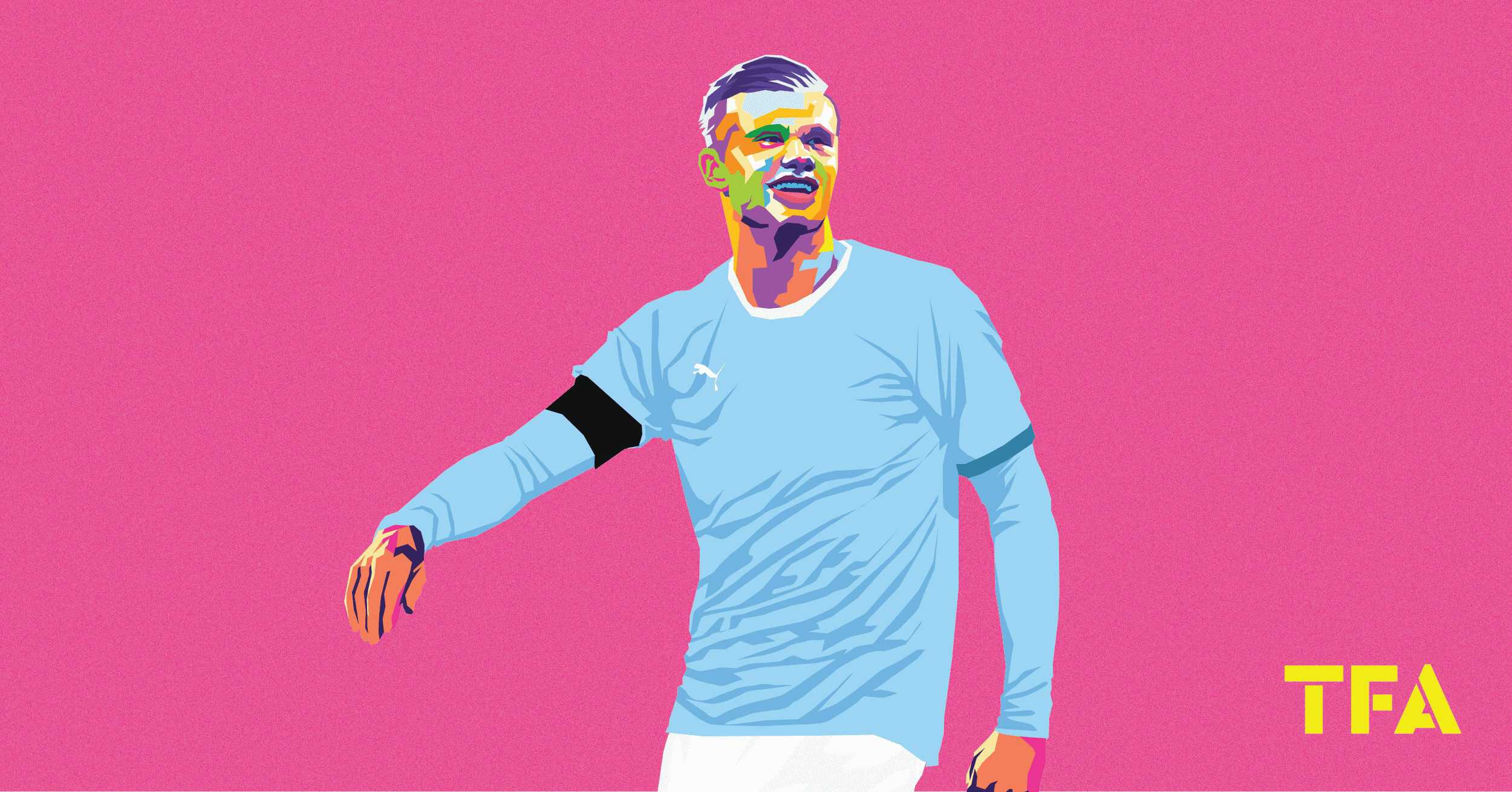

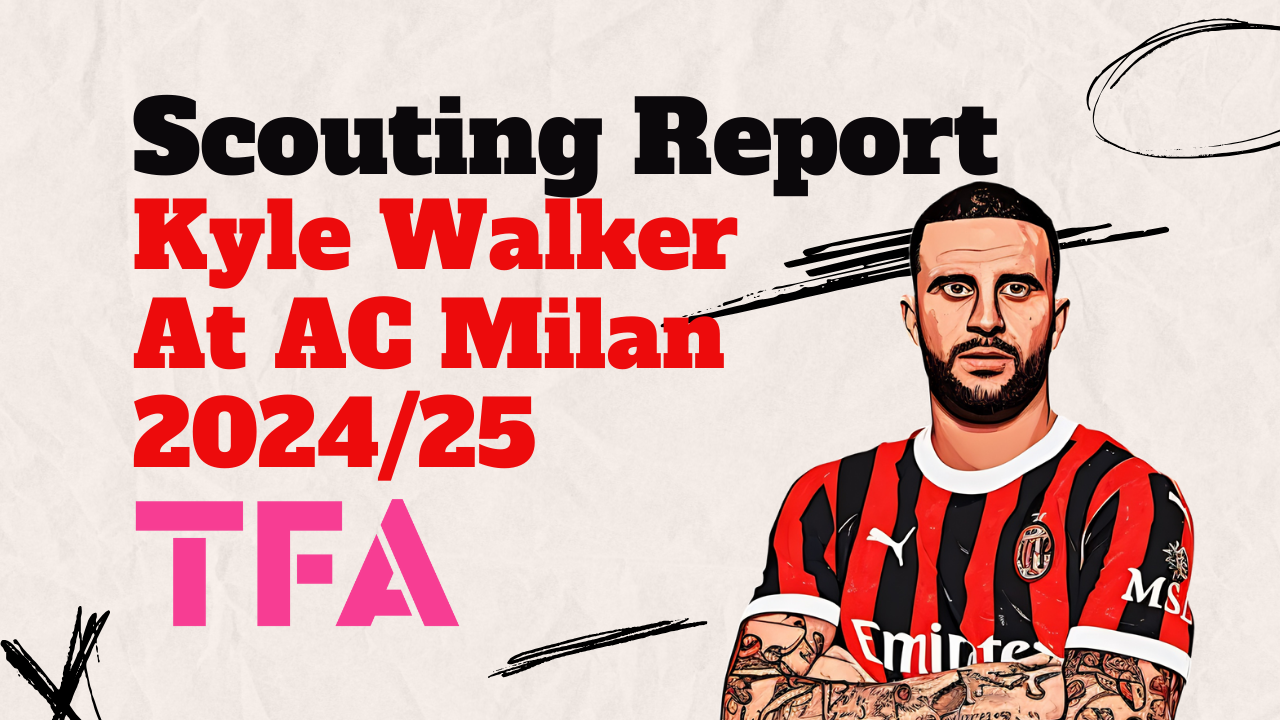
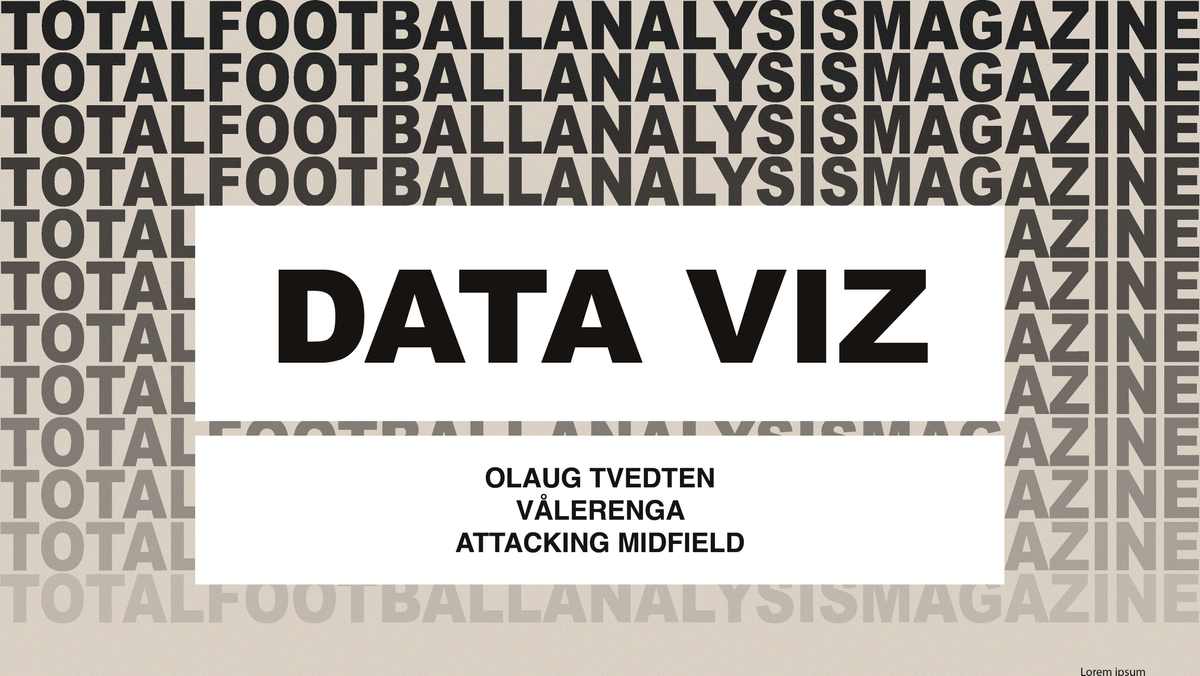
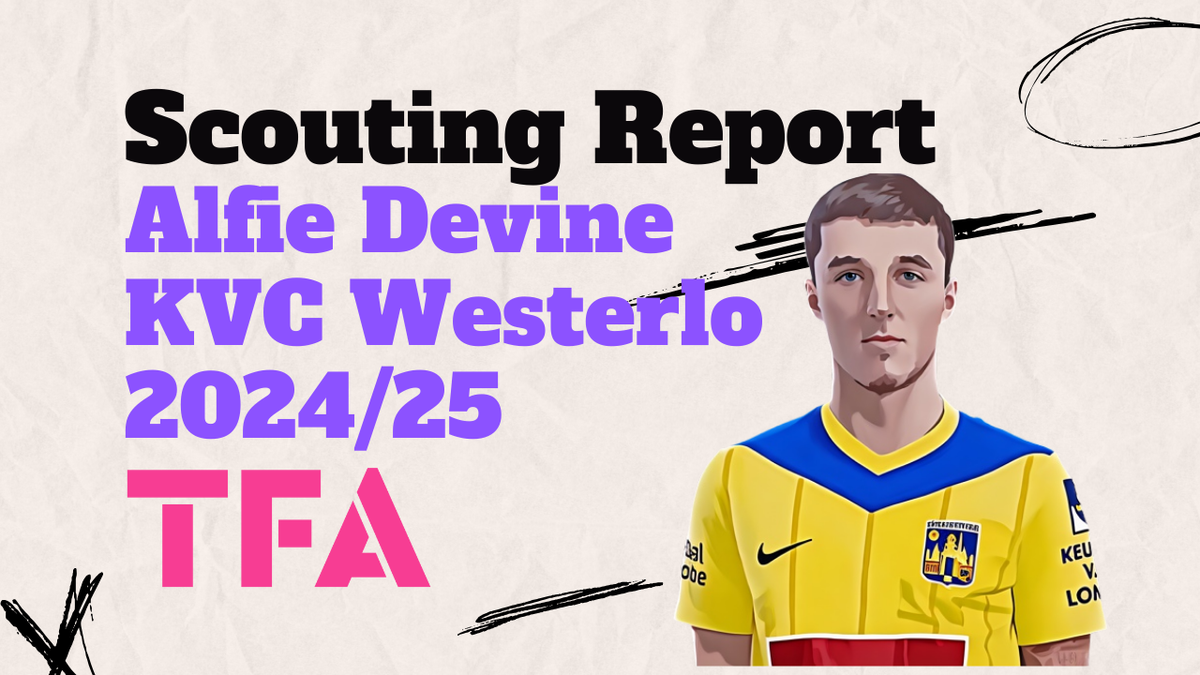
Comments